News
[2022-01-17]
Celebrating 11th of February in the High-Energy Astrophysics community: AstroSciku contest
As every 11th of February the Athena Community Office is joining the celebrations of the International Day of Girls and Women in Science with the aim of showing the contributions of women to science and in particular to the field of astronomy and astrophysics.This year we present a joint international initiative of the Athena Community Office, the XMM2Athena project, the X-IFU and WFI consortia and the AHEAD2020 project launching a call for AstroSciku. An AstroSciku is an adaptation of the Japanese haiku poem form, seeking the same simplicity and capture of the moment, but focused on astronomy and, for this contest, with a gender perspective. Although there are several variants of the Scikus we will follow the traditional 3 lines long, written in English with 5-7-5 syllabic structure and no-rhyming lines (look at the Sciku project website and Twitter for help and ideas!). Participants should draw inspiration from discoveries or research made by women astronomers and astrophysicists (from all times) to create their AstroSciku. Each AstroSciku must be original and contain, in addition to the 3 verses, a title related either to the scientist to whom it refers to or to the context. Themes about high-energy astrophysics will be especially valued.
This contest is open to anyone who wants to participate. Up to two different AstroSciku may be submitted by posting them on the participant’s personal Twitter account. To be valid, the tweets must include #2022AstroSciku #WomenInScience in their posts before the 7th of February 2022.
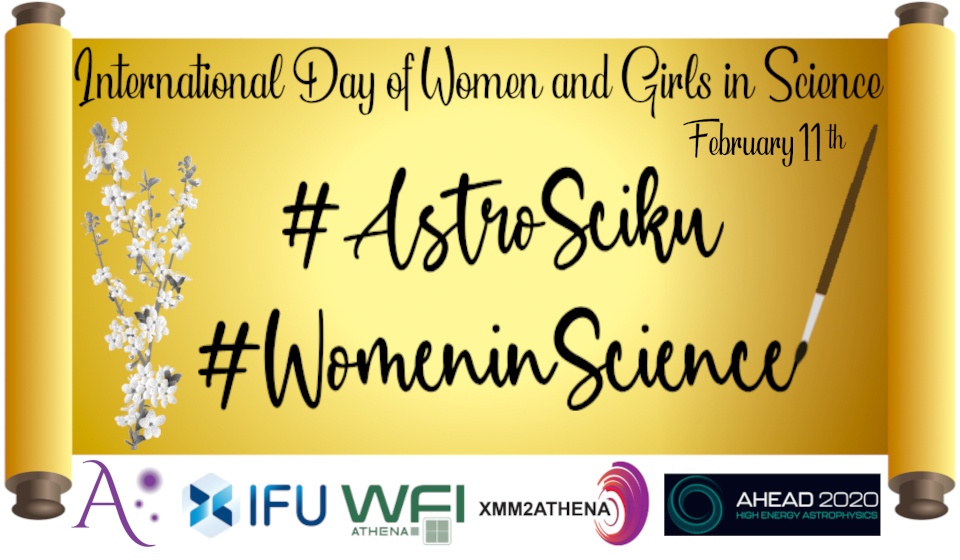
- The submission of AstroSciku starts with this publication and ends on February 7th, 2022.
- Participants: everyone can submit their AstroSciku.
- How to participate: there are two options to participate. The preferred option is to post your AstroSciku on your personal Twitter including #2022AstroSciku #WomenInScience hashtags. But if you don’t have a Twitter account, you can send us your AstroScikus to aco@ifca.unican.es and we will take care of disseminating it on ACO’s Twitter. If this is the case, please include in the email a name or alias for its publication on Twitter.
- Limits: each participant can send a maximum of 2 AstroSciku.
- Selection: three AstroSciku will be selected considering originality, relevance to the topic and accessibility by the general public. The selection will be done by members of the different teams, will be final and cannot be reconsidered. The result will be published on 11th February through the project/consortia communication channels.. The project will have the right to use the submitted AstroSciku for its communication activities.
- Prize: the first AstroSciku in the list of the three classified will receive a merchandising pack of the projects and public recognition of the author's ingenuity with the publication of the winner on social networks and the websites of the different projects involved on the 11th of February activity. Participation in this contest implies the acceptance of all these competition rules.
[2021-05-04]
WFI Consortium Meeting #13
The 13th in the series of semi-annual meetings of the WFI Consortium was held from April 26th to 29th 2021. For the third time in a row, the gathering as organized fully in virtual space, bringing together representatives of all WFI Consortium Partner Institutes, Japan, the Czech Republic, ESA, the German Space Agency, and the X-IFU Consortium.The plenary sessions kicked off with mission level presentations by ESA representatives P. McNamara, M. Ayre, M. Guainazzi, N. Boudin, and a report on the status of the optics development by M. Bavdaz (also ESA). Focus then shifted to discussing the latest news about the instrument and all of its subsystems. A summary of the status of the X-IFU was given by its PI D. Barret (IRAP). The plenary sessions were accompanied by a series of splinters concentrating on specific topics related to the instrument development, science, science ground segment, and non-X-ray background.
A special session was dedicated to discussing new WFI science ideas. Th. Reiprich (Univ. Bonn) presented highlights from the first eROSITA observations of WHIM filaments associated to nearby galaxies and emphasized the scientific potential of an implementing and efficient large area scanning mode for Athena. A. Majczyna (NCNR) reported on the prospects for Athena precision mass and radius determination for neutron stars.
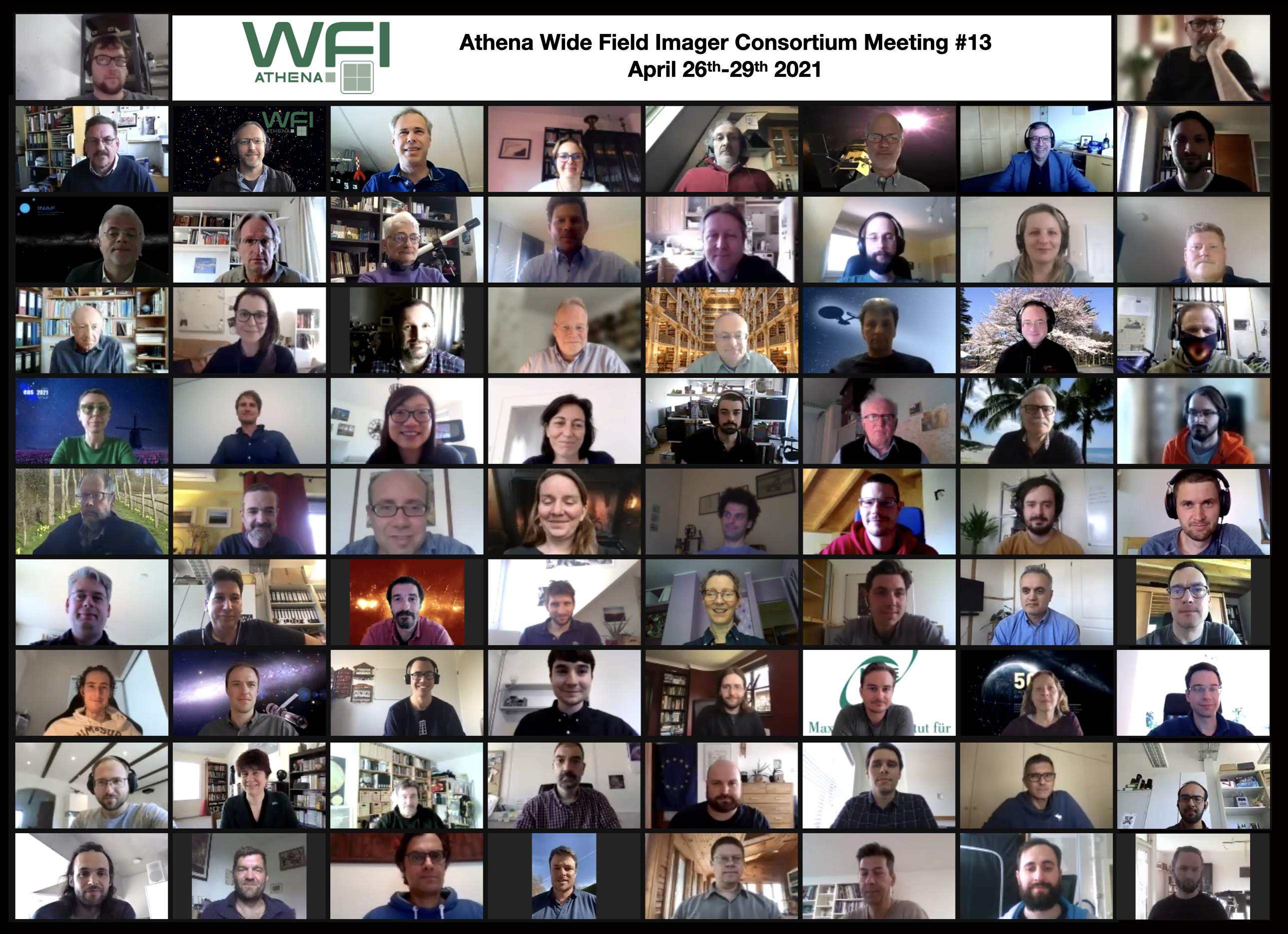
[2020-11-17]
WFI Consortium Meeting #12
The 12th semi-annual meeting of the WFI Consortium was held from November 9th to November 12th. Once again fully in virtual space, the meeting was joined by up to 120 participants at peak, representing the 23 WFI Consortium Partner Institutes, ESA, the German Space Agency DLR, Japan, the Czech Republic, and the X-IFU Consortium.In a combination of plenary and splinter sessions, the latest news on the instrument and all of its subsystems were shared and discussed. Despite notable impact caused by restrictions relating to the pandemic, progress was reported for all critical development aspects of the WFI. A particular highlight was the successful vibration test of the optical blocking filters demonstrating that the very large and thin filter will survive the loads imposed on it during launch.
A special session was dedicated to discussing new WFI science ideas, including galactic ISM and hot haloes, cluster cosmology, extragalactic transients and new physics beyond the standard model.
The plenary session also included presentations by M. Guainazzi (ESA), A. Stefanescu (ESA), the X-IFU PI D. Barret (IRAP) as well as a summary of the Athena reference telescope performance (by R. Willingale, Leicester University).
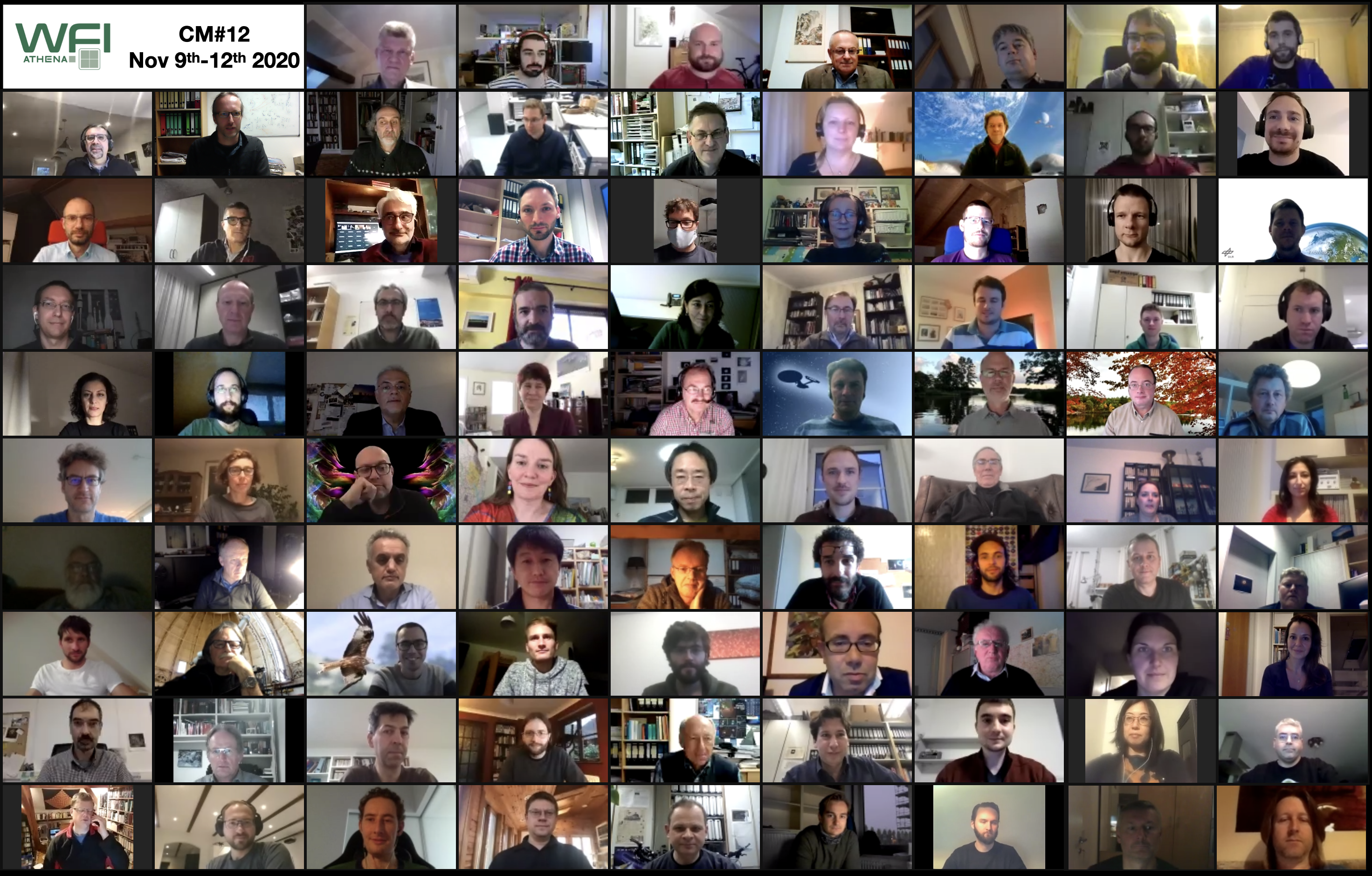
[2020-04-30]
WFI Consortium Meeting #11
The 11th semi-annual meeting of the WFI Consortium was held from April 27th to April 30th. Owing to the challenging impact of COVID-19 all over the world, the meeting was not, as initially planned, hosted at MPE, but for the first time moved entirely in to virtual space.Even though it was held in a different format, the meeting once again offered the opportunity to share and discuss the status and latest news on the instrument, its science and all of its subsystems.
The virtual format enabled the attendance of the largest number of participants at a WFI Consortium Meeting so far, with more than 110 at peak, representing all 23 WFI Consortium Partner Institutes, ESA, the German Space Agency DLR, Japan, and the X-IFU Consortium.
Progress has been made in all of the critical development aspects of the WFI. While the impact of the work and travel restrictions in all partner countries could be felt, the instrument development continues to steadily move forward towards the next important milestone, the System Requirements Review.
The plenary session also included presentations by M. Ayre (ESA), A. Stefanescu (ESA), the X-IFU PI D. Barret as well as a summary of the Athena optics development (by M. Bavdaz, ESA).
The next consortium meeting will be held in autumn 2020.
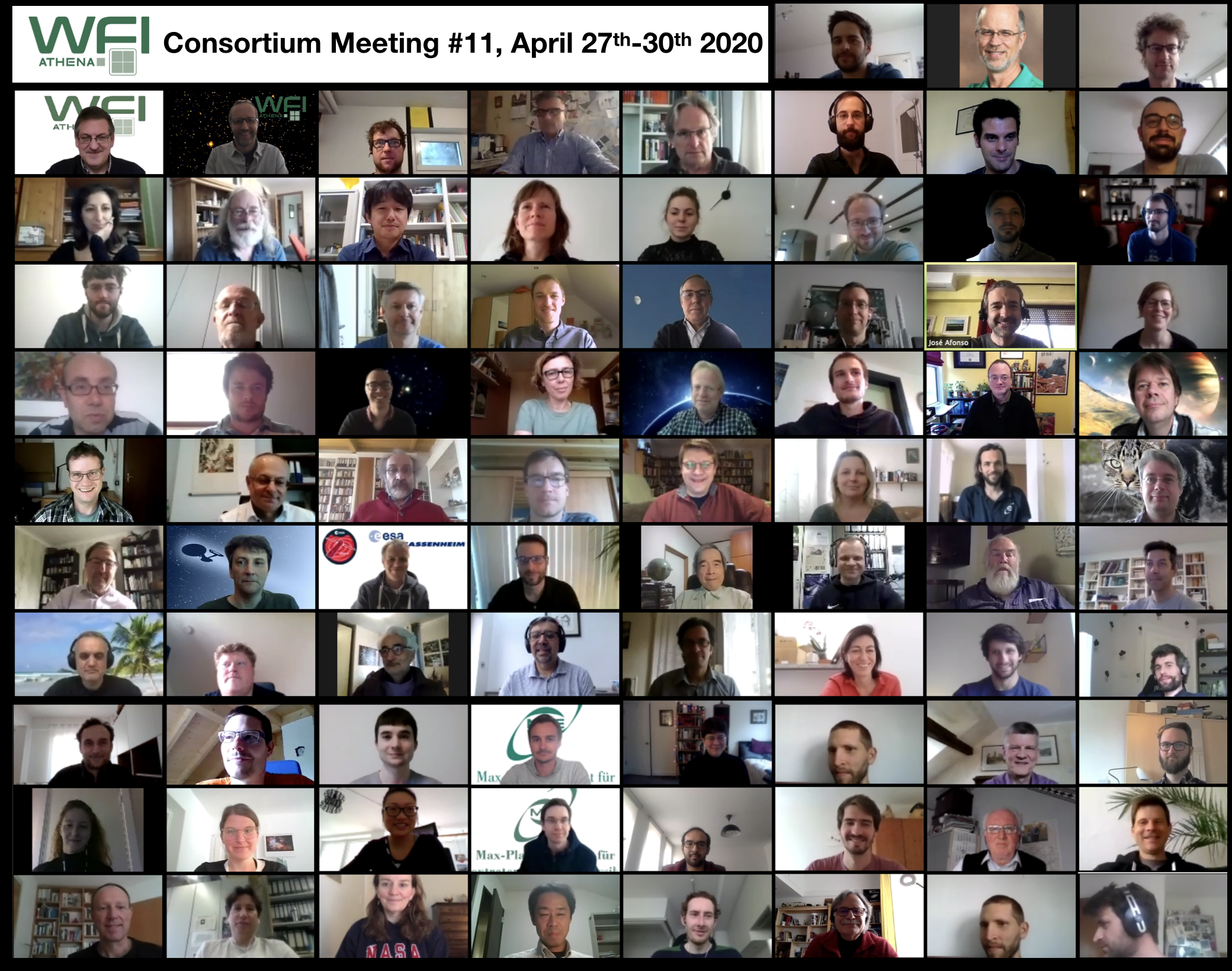
[2019-10-14]
WFI Consortium Meeting #10
Between October 14th and 17th, the WFI Consortium met again for the its semi-annual gathering. The 10th consortium meeting was held at the University and the Astronomical Observatory in Strasbourg, France. It was attended by ~75 members from nearly all of the 23 Consortium Partner Institutes, as well as representatives from ESA, the German Space Agency DLR, and the X-IFU Consortium.Following the successful Instrument Preliminary Requirements Review in November 2018 the WFI is currently in Phase B1 (Preliminary Definition) and the instrument development continues full steam ahead towards the next milestone, the System Requirements Review in spring 2021, ahead of mission adoption expected in late 2021. The Consortium Meeting was an opportunity to share and discuss the status and latest news on the instrument, its science and all of its subsystems.
Impressive progress has been made in all of the critical development aspects of the WFI. The first batch of the pre-flight DEPFET sensor production has been completed at the Semiconductor Laboratory of the Max Planck Society and the devices are now under test at MPE. First results indicate the expected excellent performance.
The large collecting area of the Athena optics coupled with the impressive readout times of the detectors (5ms for the Large Detector Array and 80µs for the Fast Detector) generate high data rates that need to be processed in the Detector Electronics in real time. In order to demonstrate this capability a breadboard test setup of the Frame Processor has been developed. Using digital data from a programmable emulator, the real-time performance was successfully verified, showing that the electronics can handle sources as bright as in the case of the Fast Detector 2.5 times the Crab (~195000 photons/s) without losses. The next steps will include testing with data from a real detector.
The filter and filter wheel developments have also passed a critical milestone with a successful acoustic noise tests performed at the AGH Krakow over the summer. These tests, performed with a Filter Wheel Demonstrator and flight-representative filters, validated the survival at qualification level acoustic loads and verified that a vacuum enclosure will not be needed for the instrument. This is an important step in the optimization of the instrument within its allocated resource budgets.
The plenary session also included presentations by A. Stefanescu (ESA), the X-IFU instrument scientist F. Pajot as well as two talks summarizing the Athena optics development (by M. Bavdaz, ESA) and the Silicon Pore Optics Technology (by M. Colon, COSINE).
The next consortium meeting will be held at MPE in April 2020.

[2019-03-28]
WFI Consortium Meeting #9
The 9th WFI Consortium Meeting was held from March 26th to 28th at the Max Planck Institute for Extraterrestrial Physics in Garching, Germany. This was the first meeting after the official endorsement of the WFI Consortium by ESA at the end of 2018 and focused mainly on the activities performed following the successful Instrument Preliminary Requirements Review in November 2018. WFI is now in Phase B1 (Preliminary Definition) and the instrument development continues full steam ahead towards the next milestone, the Mission Formulation Review in autumn 2019.The Consortium Meeting was attended by ~90 members from nearly all 23 Consortium Partner Institutes, as well as representatives from ESA and DLR. It started with a series of splinter sessions, dedicated to the filters and filter wheel assembly and the detector electronics, and instrument control electronics. Simultaneously, the WFI Science Team assembled to review and discuss the ongoing science assessment activities.
Over the next two days, the plenary session provided details of the status of the mission, the WFI instrument, and all of its subsystems.
Continued testing of the proto-type DEPFET sensors together with their front-end electronics has demonstrated excellent spectroscopic performance and confirmed the feasibility of operation in window mode. The team now eagerly awaits the end of the pre-flight DEPFET sensor production at the Semiconductor Laboratory of the Max Planck Society, which includes full scale 512x512 devices. The first devices are expected to be available in early summer 2019 and tests will start immediately thereafter.
The filter and filter wheel developments are progressing steadily and acoustic noise tests at AGH Krakow are scheduled for later this year. To further improve the stress resistance of the large optical blocking filter under static and dynamic loads a new honeycomb mesh structure was introduced. A positive side effect of this mesh is a smaller surface and thus a further improvement in transmission at all energies.
The plenary session showed progress also of the electronics development as well as an update on the end-to-end simulator by the SIXTE team. A report on the sensitivity analysis and in particular the impact on the multi-tiered WFI survey was given by J. Aird. Additional presentations by A. Stefanescu (ESA), TWG co-chair R. Willingale and X-IFU instrument scientist F. Pajot provided updates on the Athena mission, optics and X-IFU development, respectively. The meeting concluded by a ~1d workshop dedicated to the instrumental background, addressing the challenges associated with achieving the awaited performance.
The next consortium meeting will be hosted by the Observatoire Astronomique Strasbourg, France, in October 2019.
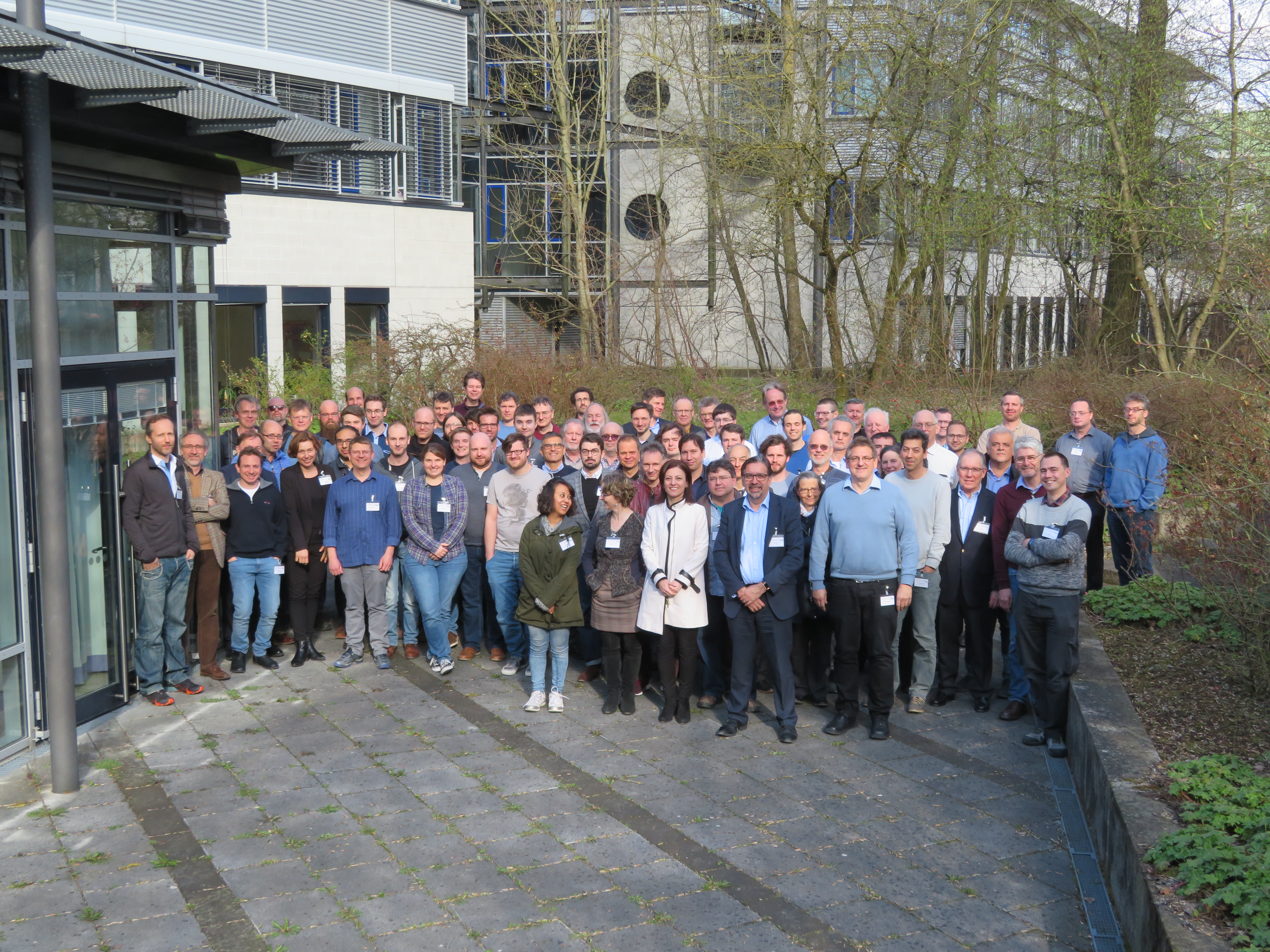
[2018-12-13]
WFI Consortium officially recognized by ESA
Following a Instrument Consortia Consolidation Process, ESA has now officially endorsed the WFI Consortium for the Athena mission! Congratulations also to our colleagues from the X-IFU![2018-11-22]
WFI Consortium Meeting #8
The WFI Consortium meeting #8 was held this week at the Faculty of Science of Lisbon University, Portugal. More than 70 engineers and scientists celebrated the successful Preliminary Requirements Review and discussed the next steps in the development of the instrument.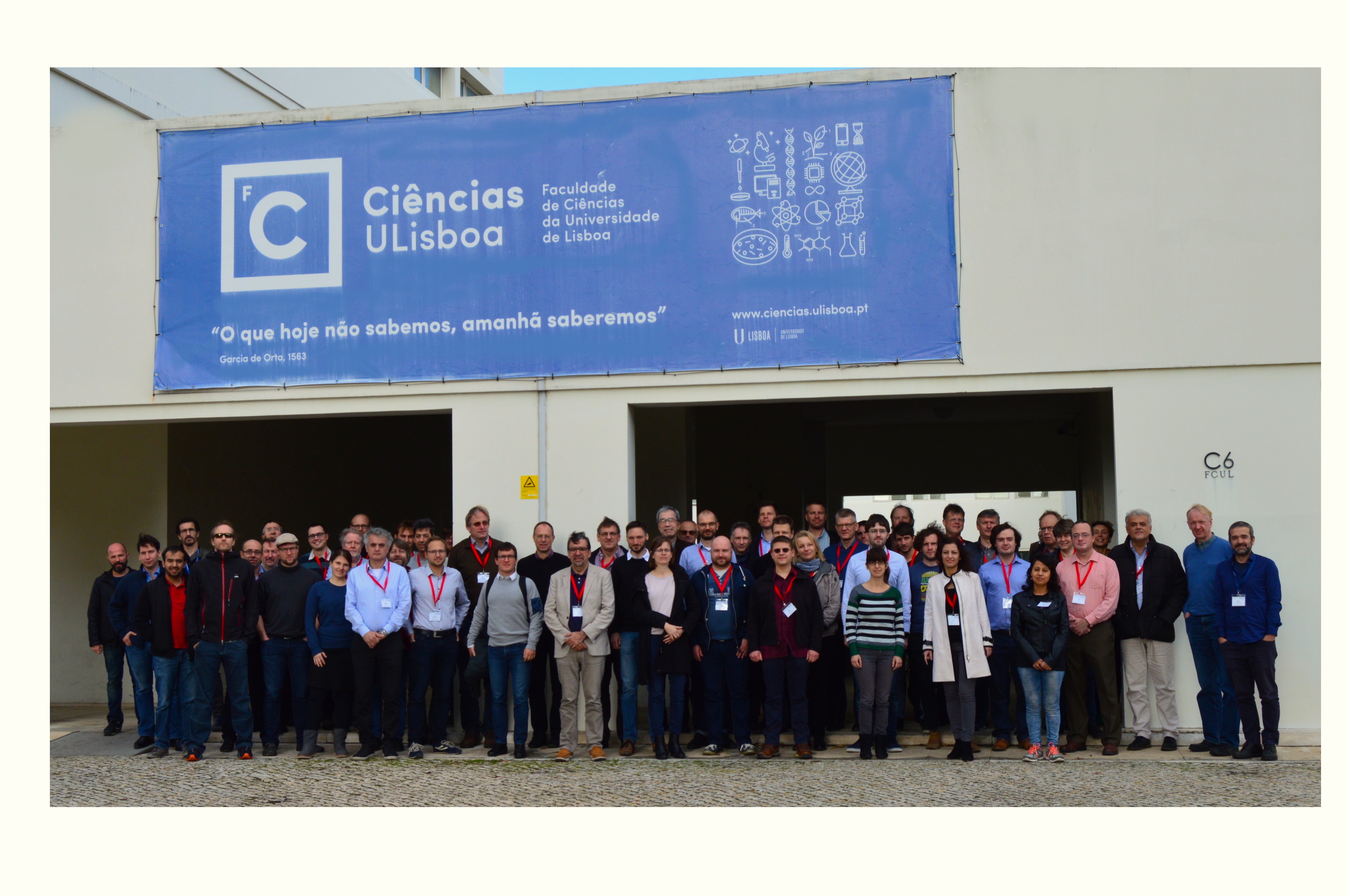
[2018-10-31]
Instrument Preliminary Requirements Review passed successfully
Today the WFI successfully passed its Instrument Preliminary Requirements Review. This is a major step for the project and we are ready to proceed forward to the next phase.[2018-10-05]
Athena Nugget #29: A DEPFET detector for Athena’s Wide Field Imager (WFI) Instrument
The WFI DEPFET detectors are the topic of the Athena Nugget #29.[2018-04-17]
WFI Proto-Consortium Meeting #7
The 7th Athena/WFI consortium has gathered 85 engineers and scientists to discuss the latest developments on all system and subsystem levels at Max Planck Institute for Extraterrestrial Physics from April 17th-19th 2018.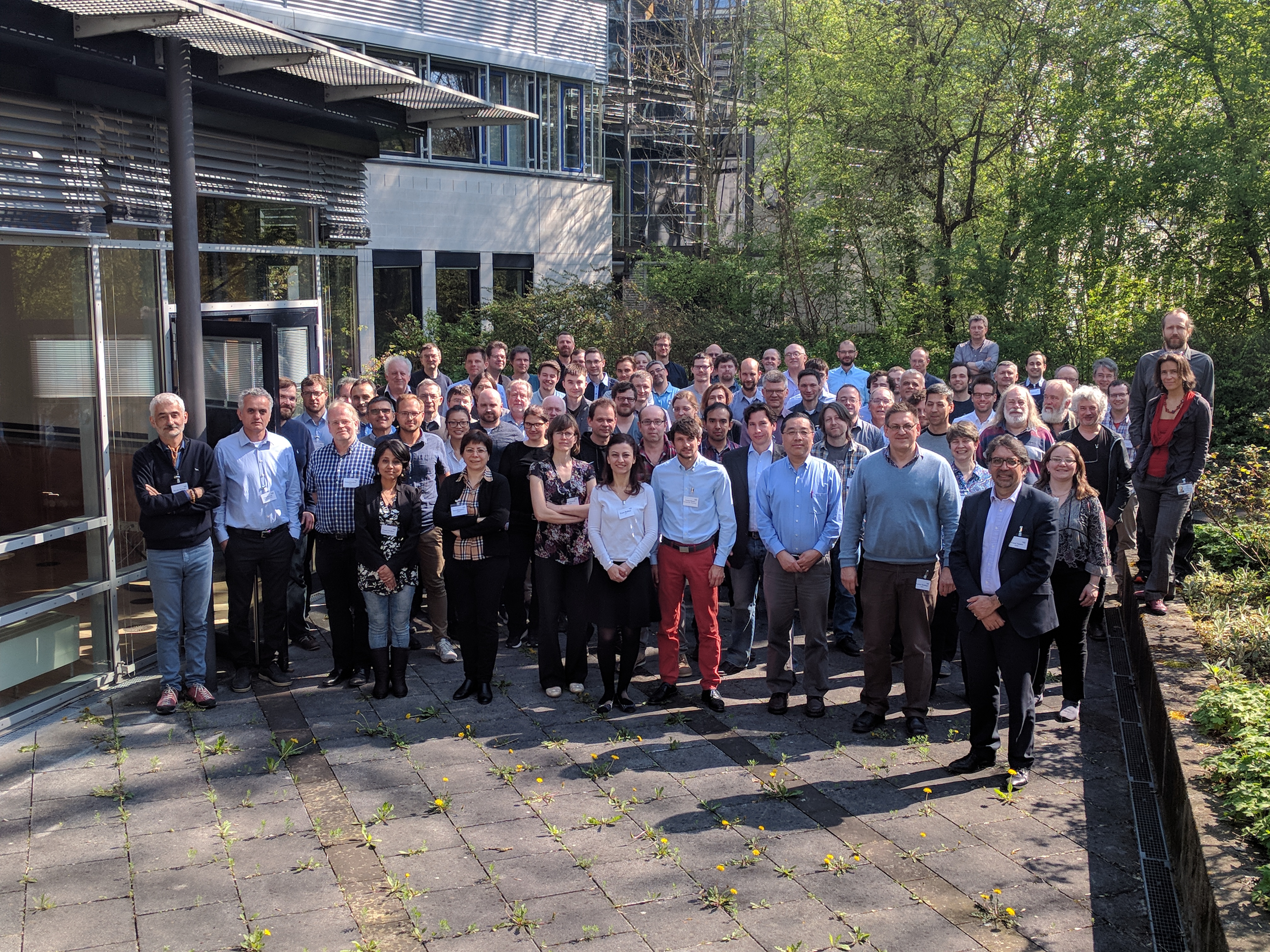
[2018-04-06]
Athena Nugget #23: Protecting the Athena/WFI from UV and visible light
Athena Nugget #23 describes what needs to be done to reduce the ultra-violet and optical light from the cosmic sources, while at the same time maximizing the transmission for X-ray photons.[2017-11-04]
Athena Nugget #17: Observing Bright Sources with the Athena-WFI
In Athena Nugget #17 we highlight the capabilities of the WFI FD for obsering the brightest X-ray sources in the sky (not counting the Sun).[2017-10-14]
WFI Proto-Consortium Meeting #6
The 6th Meeting of the Wide Field Imager Consortium was held from October 10th to 12th in the Nicolaus Copernicus Astronomical Center Warsaw, Poland. More than 70 consortium members attended to discuss the status of the instrument development, scientific activities, and plans for future work.. The meeting started with a series of splinter sessions, dedicated to specific WFI subsystems such as the filters and filter wheel assembly and the detector electronics and instrument control electronics. In addition, the WFI Science Team assembled to review the latest updates to the science requirements and the ongoing science assessment activities. The Background Working Group discussed progress on the reduction and understanding of the instrumental background.The plenary session started later the same day with a mission status report by WFI PI and ASST Lead Scientist Kirpal Nandra followed by an Athena study status overview given by ESA’s Payload Manager Alexander Stefanescu. Over the course of next two days the instrument subsystems were discussed in detail. Highlights include the development of the DEPFET sensors, which is making excellent progress with successful test of proto-type detectors. The production of the proto-flight sensors has started. First vibration test of the supporting mesh for the large optical/UV light-blocking filters were also successful and the next tests with flight-like filters are in preparation. All other subsystems, e.g., electronics, filter wheel, thermal, and mechanical are progressing well. Francoise Pajot kindly provided a report on the X-IFU status.
The plenary session also included an update on the end-to-end simulator by the SIXTE team as well as presentations on the astrophysics with the WFI, in particular the multi-tiered survey and the potential for the WFI Fast Detector to constrain the accretion geometry near the event horizon of stellar mass black holes.
We are most grateful to the hosts of the meeting Agata Rozanska and Piotr Zycki of CAMK for the excellent organisation of the meeting and their hospitality, including a memorable conference dinner in historical old-town Warsaw. The pork knuckles and beer were impressive, even by Bavarian standards!
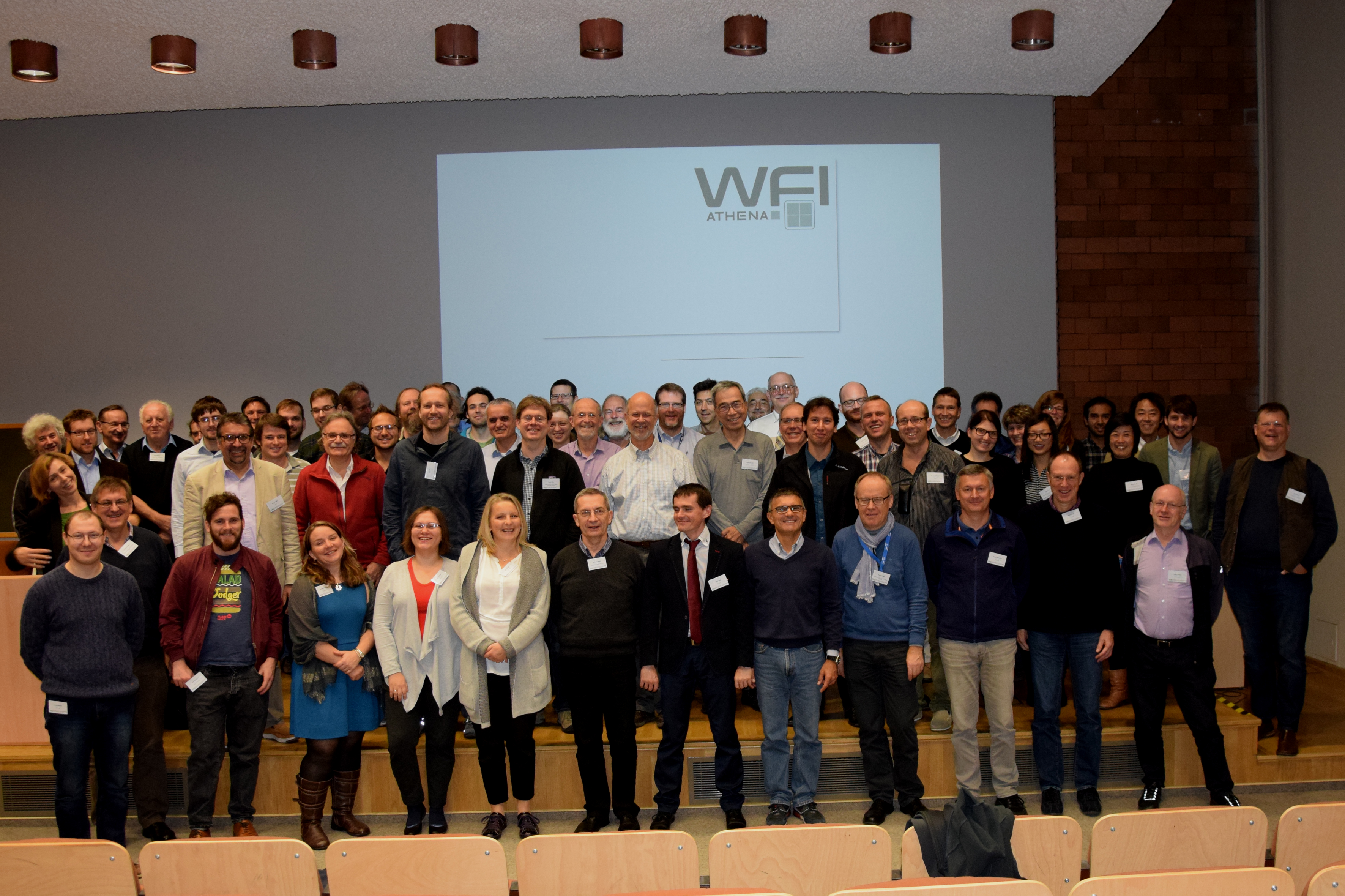
[2017-09-27]
Athena Nugget #15: Athena Instrument Background
The challenges for achieving a low instrumental background for both Athena instruments is summarized in Athena Nugget #17.[2017-03-02]
Athena Nugget #10: The Wide Field Imager
The WFI is the topic of the Athena Nugget #10, a series of short scientific and technical highlight reports around the Athena Mission published by the Athena Community Office.[2017-01-11]
New WFI Logo
The new logo for the WFI has been produced together with the Munich-based design studio SGW. We hope you like it!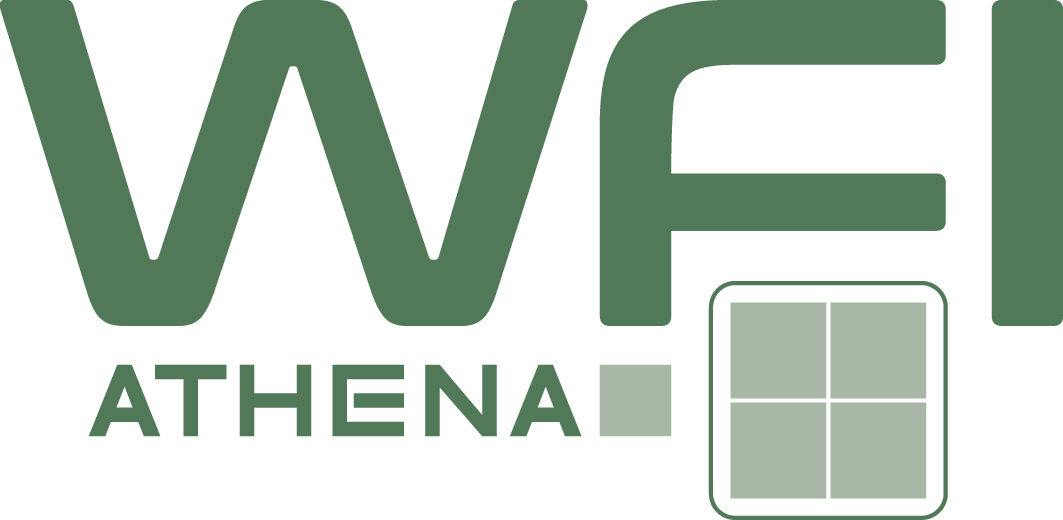
[2016-Dec-20]
Athena Community Newsletter #2
The 2nd issue of the Athena Community Newsletter has been released by the Athena Community Office. Read more about the mission, science and instrument, including an update on the WFI here:2nd Athena Community Newsletter
[2016-Jul-26]
WFI SPIE Contributions linked
You can find all WFI-related contributions to the 2016 SPIE on Astronomical Telescopes + Instrumentation here:WFI SPIE 2016 Contributions
[2016-Jun-23]
ATHENA Community Support Portal Opens
The web portal of the Athena Community Office opened its doors and provides regularly updated information about the Athena Science, Mission and Community. Go check it out here:http://www.the-athena-x-ray-observatory.eu
[2015-Sep-10]
ATHENA Working Groups open again for subscription
Application to the ATHENA science, telescope, and mission working groups is open again.Update:[ 2016-02-22] The application form is now closed again.
[2015-Sep-08]
ATHENA Science Conference
From Sep 8-10, 2015, the first scientific conference dedicated to the Athena X-ray observatory will be held at ESA/ESAC in Madird, Spain. The conference will gather together all members of the astronomical community worldwide who have an interest in Athena and discuss the key science questions for Exploring the Hot and Energetic Universe.More information can be found here:
http://www.sciops.esa.int/index.php?project=CONF2015&page=ATHENA2015